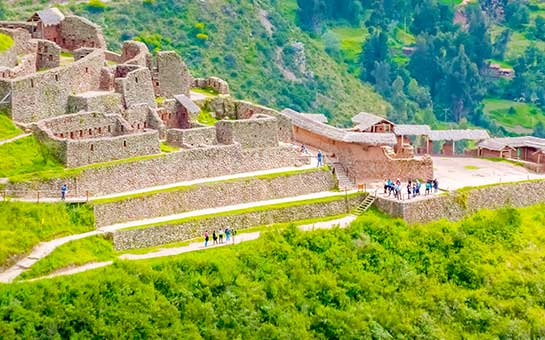The Incan Ruins are a sight to behold. They are the remnants of the Inca Empire, which rose to great prominence in the 13th century in Pre-Columbian South America. The ruins are located predominantly in Peru and stretch across Western Ecuador, Central and Western Bolivia, northwest Argentina, and a vast section of Chile.
The ruins are without a doubt worth visiting for history buffs, or even tourists at large who happen to be in the area. But before leaving on vacation, be sure to purchase travel medical insurance to stay covered in case of any unfortunate mishaps.
Incan Ruins Travel Medical Insurance for International Travelers – FAQs
Travel medical insurance will help cover costs of treatment should you fall sick or if you are injured.
Do I need travel medical insurance for Incan Ruins?
Travel medical insurance is not mandatory if you plan a trip to the Incan Ruins. However, when traveling abroad, it is always a good idea to stay protected against potentially devastating financial costs.
Why buy travel medical insurance for Incan Ruins?
Since you will be trekking and hiking over huge stretches while exploring the Incan Ruins, travel medical insurance is still a must-have, if not legally required.
Travel medical insurance will cover the cost of treatment for injuries if you suddenly fall or trip during the expedition at Incan Ruins—or if you are injured in a natural disaster, as the region is prone to activities like earthquakes and cyclones.
Things to Do for Travelers Visiting Incan Ruins
The Incan Ruins are extensive, spanning across five South American countries. The remnants of this mighty civilization have lured explorers and adventurers from around the world for centuries. Some of the most mesmerizing spots are as follows:
- Machu Picchu: This is the most well-preserved of all Incan ruins sites. The citadel at its center supposedly served as the citizens’ main gathering point. The civilization worshipped the sun, and the citadel has ancient runes and images carved in stone depicting rituals of sun worship.
- Pisac: Pisac is a fortress town situated on a hilltop in the Sacred Valley on the eastern edge of the ruins. The surrounding mountains have a terraced landscape overlooking a spectacular gorge. The complex contains the royal baths, a temple for the Sun God, temples meant for sacrifices, and study chambers dedicated to astronomy.
- Moray: Moray is known for its ingenious terrace cultivation system, and most of the people in the region were fed by produce from this land. It is said that in times when the Incan civilization thrived, this region had the laboratories that carried out experiments on how to grow crops on rocky lands. One of the highlights of the region is the pre-Incan salt ponds, located just a little way off in the town of Maras.
- Tipon: Tipon is one of the lesser-visited spots in the Incan Ruins, but this quaint site is located just outside the Incan capital, Cusco. The site is considered sacred because of the fountains of Tambomachay, which are believed to have medicinal and healing properties. It also housed the royal gardens, and the stone figures here will capture your attention. The irrigation system here can still provide valuable lessons about channeling water through difficult terrains.
- Raqchi: At the heart of Raqchi lies a sacred temple from the 15th century measuring 12 meters high and 92 meters long (about 40 feet high and 300 feet long). The city also has many administrative halls, bath complexes, and military barracks. Although one of the lesser-visited sites, it still has a lot to offer.
You can also, of course, take the Inca Trail, which meanders through five major ruin sites and will allow you to seamlessly explore the highlights.
Travel Risks for International Travelers Visiting Incan Ruins
Although traveling is meant to be a happy experience, mishaps can occur at any time. Here are some of the things to watch out for:
- Accidents: You will be walking for miles through ruins, and although the Incan ruins are very well preserved, there might be instances of freak accidents.
- Dengue: Peru, where the Incan Ruins are predominantly located, is notorious for dengue outbreaks. Mosquito bites can also lead to other diseases like malaria.
- Petty Crimes: Be wary of pickpockets when you are traveling through busy marketplaces. Keep your passport safe and protected at all times.
- Political unrest: Parts of the Republic of Peru have experienced some political unrest since 2017. Roadblocks and strikes inadvertently take place from time to time.
- Trip Cancellations: At times, the hotel or the tour operator might cancel your bookings. In such cases, travel insurance will help you cover the losses.
Before You Travel to the Incan Ruins - Do These
- You could take a fall while climbing the rocky landscape or trip over rough terrain. Make sure you stick to the paths your guide shows you.
- Make sure you carry mosquito-repellent spray. Sleep under a mosquito net, and get yourself checked if you find yourself feverish or having tremors.
- Do not wear expensive watches or jewelry, and avoid going to unknown parts of the ruin without a guide present.
- Try to stay updated with the local news. Do not rely too much on public transport when traveling long distances, as they are the first ones to shut down during events of major unrest. Renting a car would be worth the added expense.
